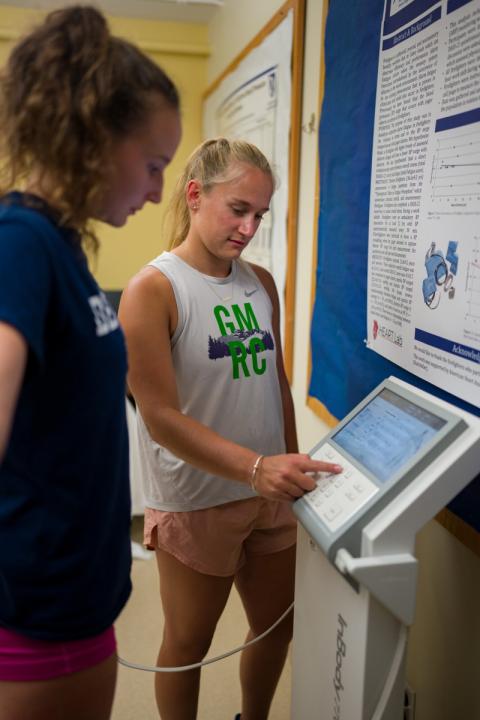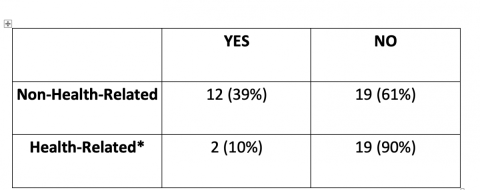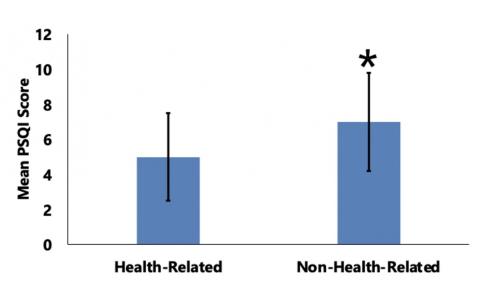Comparing Lifestyle Behaviors and Body Composition in College Students with and Without Health-Related Majors
Many college students have a hard time making healthy decisions because it is the first time in their lives that they are fully taking care of themselves. Therefore, it is important to understand what factors play a role in maintaining health and physical activity in students as they go through their college experience. One of these factors is getting adequate sleep, which can be hard for college students as they deal with additional freedom and residence hall or apartment living. Another factor, especially for students who played sports in high school, is that there is less structure to their physical activity. Without that, many struggle to meet the recommended amount of physical activity each day. This is especially hard when adjusting to new classes and trying to get their work done, all while having a more active social life. Another important factor is that most schoolwork is done on a computer or other types of screens. This combined with leisure screen time such as watching TV or spending time on phones adds up during the day.
My research, which was conducted with a Research Experience and Apprenticeship Program (REAP) grant from the Hamel Center for Undergraduate Research, examined body composition, sleep, physical activity, and screen time in college students. Recognizing that college students in health-related majors may learn and apply more healthy lifestyles than those in majors not focused on health, my research sought to determine if there were significant differences in these factors when comparing students in health-related majors to non-health-related majors across the university. My research could help evaluate if education about a healthy lifestyle would help college students develop healthy habits that they can maintain throughout their life.
Methods

The author using the InBody 770 to take measurements of a study participant.
Fifty-two college students (25 males, 27 females, aged 19.7+1.4 years) from health-related majors (n=21) and non-health-related majors (n=31) participated in this study. Health-related majors include athletic training, exercise science, health and physical education, health data science, health management and policy, health sciences, nursing, and occupational therapy. Examples of non-health related majors include economics, business administration, engineering, biology, and chemistry.
The participants were recruited by flyers posted throughout campus and on social media. Participants ranged from freshmen to graduate students. I measured their body weight, body fat percentage, body mass index, and skeletal muscle mass on the InBody 770, which is a scale with two handles that uses Bioelectrical Impedance Analysis to calculate body composition. The InBody 770 does this by sending weak electrical currents through the body and measuring the rate at which the current travels. Body fat causes greater resistance to the current than muscle mass does, and this resistance causes the current to move slowly.
Participants also completed various surveys about lifestyle habits. A screen time questionnaire that quantified participants’ screen time on weekdays, weekday nights, and weekends was given as well as the University Student Physical Activity and Sedentary Behavior Questionnaire which evaluated participants’ sitting behavior. The Pittsburg Sleep Quality Index was also used to obtain information about sleep habits and disturbances and a final score was created to quantify sleep quality. I analyzed data using independent T-tests, which compare means of two populations to determine if they are significantly different, and Chi Square tests, which determine if there are significant differences in frequencies of expected and actual values.
Results

Figure 1: Responses to the question “Do you think you are currently sitting most of the day?” *Significantly different than non-health-related majors (χ2=9.9, p=0.044).
Percent body fat and skeletal muscle mass were similar between health-related and non-health-related majors and averaged 19.8+8.5% and 31.5+7.8 kg, respectively, for the entire sample. For reference, the healthy standard for body fat percentage is 8-22% for men and 20-35% for women (Adams & Beam, 2019). Therefore, our participants were in the healthy range for percent body fat.
Screen time scores were also similar between majors and averaged 1190+513 minutes (almost 20 hours!) per week among all college students. This was not surprising considering most schoolwork is done on a computer and many leisure activities involve screens. In addition, over 90% of the total sample reported that they believe they achieve sufficient levels of physical activity on most days, showing no significant differences between majors.

Figure 2: Comparing the mean Pittsburg Quality Sleep Index between non-health-related majors and health-related majors. *Significantly better than non-health-related (P= 0.031).
However, there was a significant difference in the response to “Do you think you are currently sitting most of the day?” which was a question on the University Student Physical Activity and Sedentary Behavior Questionnaire. We found that 39% of non-health-related majors responded “yes” to this question, while only 5% of health-related majors responded “yes” (Figure 1). We also found significant differences in the Pittsburg Quality Sleep Index between health-related majors and non-health related majors. Pittsburg Quality Sleep Index scores were higher, indicating poorer sleep in non-health-related majors (Figure 2). These significant differences show that both better sleep quality and less sitting time throughout the day could contribute to a healthier lifestyle in students from health-related majors than those in non-health-related majors.
Conclusion
It is important to point out a limitation to this study. The majority of health-related students were freshmen and sophomores (76% total) while the majority of non-health-related students were juniors, seniors, and graduate students (61% total). Therefore, it is possible that the results could have turned out this way due to the difference in academic workload. Upperclassman could have more work than underclassman, so they could be sitting more and getting less sleep in order to get their work done. Also, it is possible that underclassman have more general education classes in their schedules, which are more spread across campus, leading students to walk more.
I recently presented my project at the New England American College of Sports Medicine conference in Providence, Rhode Island and am planning to present my findings at the Undergraduate Research Conference at the University of New Hampshire in spring 2023. I learned through the Research Experience and Apprenticeship Program that I enjoy the research process, so I now know that working in a research setting is something I would be happy doing. As a second-year exercise science major, I plan to conduct more research in the field, which will culminate in an Honors thesis my senior year.
I would like to thank Summer Cook for her guidance and support throughout my research project. I could not have completed this without all her help. I would also like to thank the Hamel Center for Undergraduate Research for providing the funding needed to conduct my research.
References
Adams G. M., Beam W. C. (2019). Exercise Physiology Laboratory Manual Eighth Edition. McGraw Hill Education.
Author and Mentor Bios
Originally from Northborough, Massachusetts, Amanda Ares started at the University of New Hampshire as a biology major but is planning to transfer into the exercise science major this year. She is in the University Honors Program and is part of the Association of Exercise Science Students. Last spring Amanda reached out to Dr. Summer Cook in an effort to get involved in research. Amanda started off helping fellow student Violet Sullivan with her honors thesis research, and then applied for a Research Experience and Apprenticeship Program (REAP) grant of her own. Leaning about the research process and having the freedom to define her own project made Amanda feel very independent and satisfied with her research experience. She loved presenting her project and poster at New England American College of Sports Medicine conference this fall and learning skills that will be helpful to her in the future. Amanda decided to submit to Inquiry because she thought it was the perfect place to start publishing her independent research. In all, being able to conduct, present, and now publish her research in Inquiry has helped Amanda gain valuable experience that will support her as she pursues a career in exercise physiology.
Summer Cook is an associate professor in the Department of Kinesiology at the University of New Hampshire, where she has been since 2009. She conducts research on optimizing human performance, particularly in areas of neuromuscular physiology and aging. In her time at UNH, Dr. Cook has served as a research mentor to around twenty-five different students who have earned SURF, REAP, URA, and IROP awards, including one of whom also published in Inquiry. First meeting Amanda Ares in her Contemporary Perspective in Exercise Science course, Dr. Cook took notice of Amanda’s sophisticated research skills. Together she and Amanda developed a proposal for the Research Experience and Apprenticeship Program (REAP) that was meant to complement some of the methods used in other student projects while allowing Amanda ownership of her own study. Overall, this was a very rewarding experience for Dr. Cook. She was happy that Amanda could present her research at the New England American College of Sports Medicine conference and gain that experience so early on in her education. Dr. Cook believes that everyone should be able to tell the story of their research without all the technical and scientific jargon that can sometimes overshadow the overall research experience. She feels that being able to publish their work in Inquiry gives students a valuable opportunity to share research not only with other researchers, but with the general public as well.
Copyright 2022, Amanda Ares